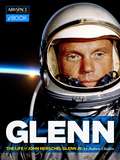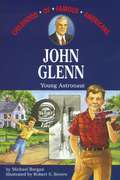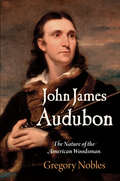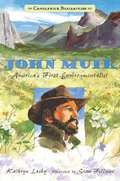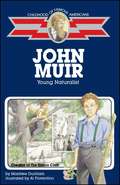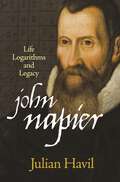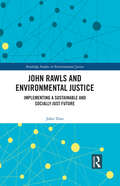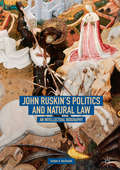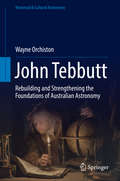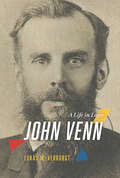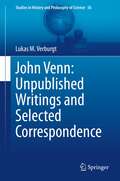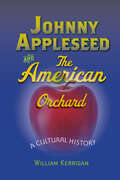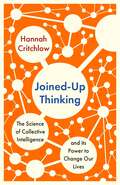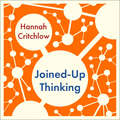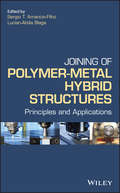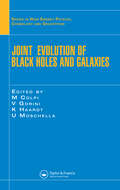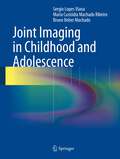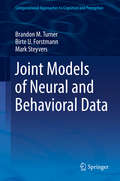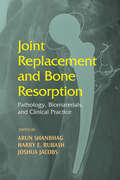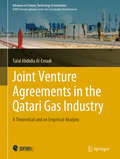- Table View
- List View
John Glenn: America's Astronaut
by Andrew ChaikinIn February 1962, he became the first American to orbit the Earth. Since then John Herschel Glenn Jr. has stood in the popular imagination as a quintessentially American hero. In John Glenn: America's Astronaut, a special edition e-book featuring 45 stunning photographs as well as a video, Chaikin explores Glenn's path to greatness. John Glenn features new details on Glenn's selection as an astronaut in 1959, newly synchronized onboard film and audio of Glenn's harrowing reentry from orbit on his 1962 Mercury mission, rarely seen images of Glenn in orbit and from the John Glenn archives at Ohio State University, as well as new, touching reminiscenes of Glenn's 1998 return to space from his Space Shuttle crewmates. Glenn is the embodiment of the history of human spaceflight and the indefatigable American spirit, and John Glenn: America's Astronaut is his amazing story.
John Glenn: Around the World in 90 Minutes
by Paul WestmanA biography of the first American to orbit the earth who is now a United States Senator from his native Ohio.
John Glenn: Young Astronaut
by Michael BurganChildren's biography of the famous American astronaut.
John James Audubon: The Nature of the American Woodsman
by Gregory NoblesJohn James Audubon's The Birds of America stands as an unparalleled achievement in American art, a huge book that puts nature dramatically on the page. With that work, Audubon became one of the most adulated artists of his time, and America's first celebrity scientist.In this fresh approach to Audubon's art and science, Gregory Nobles shows us that Audubon's greatest creation was himself. A self-made man incessantly striving to secure his place in American society, Audubon made himself into a skilled painter, a successful entrepreneur, and a prolific writer, whose words went well beyond birds and scientific description. He sought status with the "gentlemen of science" on both sides of the Atlantic, but he also embraced the ornithology of ordinary people. In pursuit of popular acclaim in art and science, Audubon crafted an expressive, audacious, and decidedly masculine identity as the "American Woodsman," a larger-than-life symbol of the new nation, a role he perfected in his quest for transatlantic fame. Audubon didn't just live his life; he performed it.In exploring that performance, Nobles pays special attention to Audubon's stories, some of which—the murky circumstances of his birth, a Kentucky hunting trip with Daniel Boone, an armed encounter with a runaway slave—Audubon embellished with evasions and outright lies. Nobles argues that we cannot take all of Audubon's stories literally, but we must take them seriously. By doing so, we come to terms with the central irony of Audubon's true nature: the man who took so much time and trouble to depict birds so accurately left us a bold but deceptive picture of himself.
John Muir
by Margaret Goff ClarkA biography of the nineteenth-century naturalist, explorer, and writer who was influential in establishing our national park system.
John Muir
by Thomas LockerLaced with richly painted landscapes, this book brings readers the world and words of John Muir. This is the second book in a series of illustrated books by Thomas Locker that introduces readers to notable people who loved and wrote about the American land, especially about the value of wilderness.
John Muir: America's First Environmentalist (Candlewick Biographies)
by Kathryn Lasky Stan FellowsFrom the meadows of Scotland to the farms of Wisconsin, from the swamps of Florida to the Alaskan tundra, John Muir loved the land. Born in 1838, he was a writer, a scholar, an inventor, a shepherd, a farmer, and an explorer, but above all, he was a naturalist. John Muir was particularly devoted to the high cliffs, waterfalls, and ancient giant sequoia trees that, through his careful influence, were set aside as one of the first national parks in America - Yosemite. Here is the life story of the man who, moved by a commitment to wilderness everywhere, founded the Sierra Club in 1892, a conservation group that carries on his crucial work to this day.
John Muir: Young Naturalist (Childhood of Famous Americans Series)
by Montrew DunhamA founding father of the conservation movement in the United States, John Muir was born in Scotland and emigrated to Wisconsin when he was eleven. This easy-to-read fictionalized biography takes a look at Muir's life as young naturalist, destined to become one of America's first eco-heroes.
John Napier: Life, Logarithms, and Legacy
by Julian HavilThe most comprehensive account of the mathematician's life and workJohn Napier (1550–1617) is celebrated today as the man who invented logarithms—an enormous intellectual achievement that would soon lead to the development of their mechanical equivalent in the slide rule: the two would serve humanity as the principal means of calculation until the mid-1970s. Yet, despite Napier's pioneering efforts, his life and work have not attracted detailed modern scrutiny. John Napier is the first contemporary biography to take an in-depth look at the multiple facets of Napier’s story: his privileged position as the eighth Laird of Merchiston and the son of influential Scottish landowners; his reputation as a magician who dabbled in alchemy; his interest in agriculture; his involvement with a notorious outlaw; his staunch anti-Catholic beliefs; his interactions with such peers as Henry Briggs, Johannes Kepler, and Tycho Brahe; and, most notably, his estimable mathematical legacy.Julian Havil explores Napier’s original development of logarithms, the motivations for his approach, and the reasons behind certain adjustments to them. Napier’s inventive mathematical ideas also include formulas for solving spherical triangles, "Napier’s Bones" (a more basic but extremely popular alternative device for calculation), and the use of decimal notation for fractions and binary arithmetic. Havil also considers Napier’s study of the Book of Revelation, which led to his prediction of the Apocalypse in his first book, A Plaine Discovery of the Whole Revelation of St. John—the work for which Napier believed he would be most remembered.John Napier assesses one man’s life and the lasting influence of his advancements on the mathematical sciences and beyond.
John Rawls and Environmental Justice: Implementing a Sustainable and Socially Just Future (Routledge Studies in Environmental Justice)
by John TönsUsing the principles of John Rawls’ theory of justice, this book offers an alternative political vision, one which describes a mode of governance that will enable communities to implement a sustainable and socially just future. Rawls described a theory of justice that not only describes the sort of society in which anyone would like to live but that any society can create a society based on just institutions. While philosophers have demonstrated that Rawls’s theory can provide a framework for the discussion of questions of environmental justice, the problem for many philosophical theories is that discussions of sustainable development open the need to address questions of ecological interdependence, historical inequality in past resource use and the recognition that we cannot afford to ignore the limitations of growth. These ideas do not fit in comfortably in standard discourse about theories of justice. In contrast, this book frames the discussion of global justice in terms of environmental sustainability. The author argues that these ideas can be used to develop a coherent political theory that reconciles cosmopolitan arguments and the non-cosmopolitan or nationalist arguments concerning social and environmental justice. This book will be of great interest to students and scholars of environmental philosophy and ethics, moral and political philosophy, global studies and sustainable development.
John Ruskin's Politics and Natural Law: An Intellectual History
by Graham A. MacDonaldThis book offers new perspectives on the origins and development of John Ruskin’s political thought. Graham A. MacDonald traces the influence of late medieval and pre-Enlightenment thought in Ruskin’s writing, reintroducing readers to Ruskin’s politics as shaped through his engagement with concepts of natural law, legal rights, labour and welfare organization. From Ruskin’s youthful studies of geology and chemistry to his back-to-the-land project, the Guild of St. George, he emerges as a complex political thinker, a reformer—and what we would recognize today as an environmentalist. John Ruskin’s Politics and Natural Law is a nuanced reappraisal of neglected areas of Ruskin’s thought.
John Tebbutt
by Wayne OrchistonThis book marks the centennial of Tebbutt's death with a major biographical account surveying his scientific contributions to astronomy, prefaced with a foreword by Sir Patrick Moore. During the second half of the nineteenth century, Tebbutt was Australia's foremost astronomer. He devoted his time and funds to astronomy, and built a truly international reputation that far surpassed Australia's leading professional astronomers of the day. This book marks the centennial of Tebbutt's death with a major biographical account. Tebbutt's remarkable record of achievement extends over more than half a century. Orchiston's book covers the whole of Tebbutt's career, from his yearly observatory reports and comet discoveries to his time as the first president of Sydney's branch of the British Astronomical Association.
John Venn: A Life in Logic (Studies In History And Philosophy Of Science Ser. #56)
by Lukas M. VerburgtThe first comprehensive history of John Venn’s life and work. John Venn (1834–1923) is remembered today as the inventor of the famous Venn diagram. The postmortem fame of the diagram has until now eclipsed Venn’s own status as one of the most accomplished logicians of his day. Praised by John Stuart Mill as a “highly successful thinker” with much “power of original thought,” Venn had a profound influence on nineteenth-century scientists and philosophers, ranging from Mill and Francis Galton to Lewis Carroll and Charles Sanders Peirce. Venn was heir to a clerical Evangelical dynasty, but religious doubts led him to resign Holy Orders and instead focus on an academic career. He wrote influential textbooks on probability theory and logic, became a fellow of the Royal Society, and advocated alongside Henry Sidgwick for educational reform, including that of women’s higher education. Moreover, through his students, a direct line can be traced from Venn to the early analytic philosophy of G. E. Moore and Bertrand Russell, and family ties connect him to the famous Bloomsbury group. This essential book takes readers on Venn’s journey from Evangelical son to Cambridge don to explore his life and work in context. Drawing on Venn’s key writings and correspondence, published and unpublished, Lukas M. Verburgt unearths the legacy of the logician’s wide-ranging thinking while offering perspective on broader themes in religion, science, and the university in Victorian Britain. The rich picture that emerges of Venn, the person, is of a man with many sympathies—sometimes mutually reinforcing and at other times outwardly and inwardly contradictory.
John Venn: A Life in Logic (Studies In History And Philosophy Of Science Ser. #56)
by Lukas M. VerburgtThe first comprehensive history of John Venn’s life and work. John Venn (1834–1923) is remembered today as the inventor of the famous Venn diagram. The postmortem fame of the diagram has until now eclipsed Venn’s own status as one of the most accomplished logicians of his day. Praised by John Stuart Mill as a “highly successful thinker” with much “power of original thought,” Venn had a profound influence on nineteenth-century scientists and philosophers, ranging from Mill and Francis Galton to Lewis Carroll and Charles Sanders Peirce. Venn was heir to a clerical Evangelical dynasty, but religious doubts led him to resign Holy Orders and instead focus on an academic career. He wrote influential textbooks on probability theory and logic, became a fellow of the Royal Society, and advocated alongside Henry Sidgwick for educational reform, including that of women’s higher education. Moreover, through his students, a direct line can be traced from Venn to the early analytic philosophy of G. E. Moore and Bertrand Russell, and family ties connect him to the famous Bloomsbury group. This essential book takes readers on Venn’s journey from Evangelical son to Cambridge don to explore his life and work in context. Drawing on Venn’s key writings and correspondence, published and unpublished, Lukas M. Verburgt unearths the legacy of the logician’s wide-ranging thinking while offering perspective on broader themes in religion, science, and the university in Victorian Britain. The rich picture that emerges of Venn, the person, is of a man with many sympathies—sometimes mutually reinforcing and at other times outwardly and inwardly contradictory.
John Venn: Unpublished Writings and Selected Correspondence (Studies in History and Philosophy of Science #56)
by Lukas M. VerburgtThis is the first book to present a carefully chosen and annotated selection of the unpublished writings and correspondence of the English logician John Venn (1834-1923). Today remembered mainly as the inventor of the famous diagram that bears his name, Venn was an important figure of nineteenth-century Cambridge, where he worked alongside leading thinkers, such as Henry Sidgwick and Alfred Marshall, on the development of the Moral Sciences Tripos. Venn published three influential textbooks on logic, contributed some dozen articles to the then newly-established journal Mind, of which he became co-editor in 1892, and counted F.W. Maitland, William Cunningham and Arthur Balfour among his pupils. After his active career as a logician, which ended around the turn of the 20th century, Venn reinvented himself as a biographer of his University, College and family. Together with his son, he worked on the massive Alumni Cantabrigienses, which is still used today as a standard reference source. The material presented here, including the 100-page Annals: Autobiographical Sketch, provides much new information on Venn's philosophical development and Cambridge in the 1850s-60s. It also brings to light Venn's relation with famous colleagues and friends, such as Leslie Stephen, Francis Galton, and William Stanley Jevons, thereby placing him at the heart of Victorian intellectual life.
John Wilkins 1614-1672: An Intellectual Biography
by Barbara J. ShapiroThis title is part of UC Press's Voices Revived program, which commemorates University of California Press’s mission to seek out and cultivate the brightest minds and give them voice, reach, and impact. Drawing on a backlist dating to 1893, Voices Revived makes high-quality, peer-reviewed scholarship accessible once again using print-on-demand technology. This title was originally published in 1969.
Johnny Appleseed and the American Orchard: A Cultural History
by William KerriganA fresh look at American icon Johnny "Appleseed" Chapman and the story of the apple.Johnny Appleseed and the American Orchard illuminates the meaning of Johnny "Appleseed" Chapman’s life and the environmental and cultural significance of the plant he propagated. Creating a startling new portrait of the eccentric apple tree planter, William Kerrigan carefully dissects the oral tradition of the Appleseed myth and draws upon material from archives and local historical societies across New England and the Midwest. The character of Johnny Appleseed stands apart from other frontier heroes like Davy Crockett and Daniel Boone, who employed violence against Native Americans and nature to remake the West. His apple trees, nonetheless, were a central part of the agro-ecological revolution at the heart of that transformation. Yet men like Chapman, who planted trees from seed rather than grafting, ultimately came under assault from agricultural reformers who promoted commercial fruit stock and were determined to extend national markets into the West. Over the course of his life John Chapman was transformed from a colporteur of a new ecological world to a curious relic of a pre-market one.Weaving together the stories of the Old World apple in America and the life and myth of John Chapman, Johnny Appleseed and the American Orchard casts new light on both.
Joined-Up Thinking: The Science of Collective Intelligence and its Power to Change Our Lives
by Hannah Critchlow'A lively examination of communal endeavour... important and correct' - Steven Poole, The GuardianAt a time of existential global challenges, we need our best brainpower to solve them.So how do we create genius environments, help our brains flourish and boost group thinking?Neuroscientist and bestselling author of The Science of Fate Hannah Critchlow shows how two heads can be better than one. Almost everything we've ever achieved has been done by groups working together, sometimes across time and space. Like a hive of bees, or a flock of birds, our naturally social, interconnected brains are designed to function best collectively.New technology is helping us share our wisdom and knowledge much more diversely across race, class, gender and borders. And AI is sparking a revolution in our approach to intelligent thinking - linking us into fast-working brain-nets for problem solving.Hannah Critchlow shows all the tricks to help us work best collectively - how to cope with wildly differing opinions, balance our biases, prevent a corrupting force, and exercise our intuitive ability for the most effective outcomes. She shares compelling examples of success, at work, in families, and all team situations, and shows us how to work, play and grow with intelligence.
Joined-Up Thinking: The Science of Collective Intelligence and its Power to Change Our Lives
by Hannah CritchlowSunday Times top ten bestselling author of The Science of Fate neuroscientist Hannah Critchlow brilliantly illuminates the new science of collective intelligence, showing how it can work to improve our lives and help solve the huge global challenges confronting us.At a time of existential global challenges we need our best brainpower to solve them. We can no longer rely on the myth of the lone genius to create a breakthrough.As neuroscientist and bestselling author of The Science of Fate Hannah Critchlow shows, two heads have always been better than one. Almost everything we've ever achieved has been done by groups of people working together, sometimes across time and space. Like a hive of bees, or a flock of birds, our naturally social, interconnected brains are designed to function best collectively.New technology is helping us share our wisdom and knowledge much more diversely across race, class, gender and borders. And AI is sparking a revolution in our approach to intelligent thinking -linking us into fast-working brainnets for problem solving.Hannah Critchlow brings us an enlightening, invaluable guide to our future through the evolving new science of collective intelligence. She reveals what it says about us as human beings, shares compelling examples and stories, and shows us how best we can work collectively at work, in families, in any team situation to improve our outcomes, our wellbeing, and our prospects. (P) 2022 Hodder & Stoughton Limited
Joining of Polymer-Metal Hybrid Structures: Principles and Applications
by Sergio T. Amancio-Filho Lucian-Attila BlagaA comprehensive introduction to the concepts of joining technologies for hybrid structures This book introduces the concepts of joining technology for polymer-metal hybrid structures by addressing current and new joining methods. This is achieved by using a balanced approach focusing on the scientific features (structural, physical, chemical, and metallurgical/polymer science phenomena) and engineering properties (mechanical performance, design, applications, etc.) of the currently available and new joining processes. It covers such topics as mechanical fastening, adhesive bonding, advanced joining methods, and statistical analysis in joining technology. Joining of Polymer-Metal Hybrid Structures: Principles and Applications is structured by joining principles, in adhesion-based, mechanical fastened, and direct-assembly methods. The book discusses such recent technologies as friction riveting, friction spot joining and ultrasonic joining. This is used for applications where the original base material characteristics must remain unchanged. Additional sections cover the main principles of statistical analysis in joining technology (illustrated with examples from the field of polymer-metal joining). Joining methods discussed include mechanical fastening (bolting, screwing, riveting, hinges, and fits of polymers and composites), adhesive bonding, and other advanced joining methods (friction staking, laser welding, induction welding, etc.). Provides a combined engineering and scientific approach used to describe principles, properties, and applications of polymer-metal hybrid joints Describes the current developments in design of experiments and statistical analysis in joining technology with emphasis on joining of polymer-metal hybrid structures Covers recent innovations in joining technology of polymer-metal hybrid joints including friction riveting, friction spot joining, friction staking, and ultrasonic joining Principles illustrated by pictures, 3D-schemes, charts, and drawings using examples from the field of polymer-metal joining Joining of Polymer-Metal Hybrid Structures: Principles and Applications will appeal to chemical, polymer, materials, metallurgical, composites, mechanical, process, product, and welding engineers, scientists and students, technicians, and joining process professionals.
Joint Evolution of Black Holes and Galaxies
by M Colpi V Gorini F Haardt U MoschellaBlack holes are among the most mysterious objects that the human mind has been capable of imagining. As pure mathematical constructions, they are tools for exploiting the fundamental laws of physics. As astronomical sources, they are part of our cosmic landscape, warping space-time, coupled to the large-scale properties and life cycle of their host
Joint Imaging in Childhood and Adolescence
by Bruno Beber Machado Maria Custódia Machado Ribeiro Sergio Lopes VianaKnowledge of the imaging appearances of the immature joint is crucial for correct image interpretation, yet this is a relatively neglected subject in the literature and in training. This book presents the essential information on imaging of the immature joint with the aim of providing radiologists (musculoskeletal specialists and generalists alike) and other specialists with a new tool that will assist greatly in overcoming the daily challenges posed by interpretation of pediatric examinations in the twenty-first century. The opening chapters consider the current role, advantages, and limitations of each modality in pediatric assessment and present the imaging appearances of anatomic and developmental peculiarities of the growing skeleton. Findings in a wide range of important conditions are then described in a series of richly illustrated chapters that present appearances on diverse imaging studies, from conventional radiography through to modern high-tech modalities.
Joint Models of Neural and Behavioral Data (Computational Approaches to Cognition and Perception)
by Birte U. Forstmann Brandon M. Turner Mark SteyversThis book presents a flexible Bayesian framework for combining neural and cognitive models. Traditionally, studies in cognition and cognitive sciences have been done by either observing behavior (e.g., response times, percentage correct, etc.) or by observing neural activity (e.g., the BOLD response). These two types of observations have traditionally supported two separate lines of study, which are led by two different cognitive modelers. Joining neuroimaging and computational modeling in a single hierarchical framework allows the neural data to influence the parameters of the cognitive model and allows behavioral data to constrain the neural model. This Bayesian approach can be used to reveal interactions between behavioral and neural parameters, and ultimately, between neural activity and cognitive mechanisms. Chapters demonstrate the utility of this Bayesian model with a variety of applications, and feature a tutorial chapter where the methods can be applied to an example problem. The book also discusses other joint modeling approaches and future directions. Joint Models of Neural and Behavioral Data will be of interest to advanced graduate students and postdoctoral candidates in an academic setting as well as researchers in the fields of cognitive psychology and neuroscience.
Joint Replacement and Bone Resorption: Pathology, Biomaterials and Clinical Practice
by Joshua J. Jacobs Arun Shanbhag Harry E. RubashThis first guide devoted to this burgeoning topic, this authoritative reference presents the current understanding of the phenomenon of aseptic loosening of total joint replacements from the molecular and cellular mechanisms of periprosthetic bone loss to the clinical presentation and management strategies-reviewing the properties of ceramic, metal
Joint Venture Agreements in the Qatari Gas Industry: A Theoretical and an Empirical Analysis (Advances in Science, Technology & Innovation)
by Talal Abdulla Al-EmadiThis book addresses a question of importance for both theory and practice: Why are joint venture agreements preferred over other types of agreements such as concession agreements, service contracts, and production sharing agreements in the Qatari gas industry? On a theoretical level, the author analyses this decision-making process by developing an approach that integrates a micro-level analysis, more specifically within international oil companies, with a macro-level analysis that spring from the organisational culture of the Qatari gas industry. At the micro level, the author proposes John Dunning’s eclectic paradigm (as one set of theoretical ideas) to explaining one element of the decision-making process leading to the preference for joint venture agreements, that is, that of international oil companies. At the macro-level, the author proposes Antony Giddens’ structuration theory (as another set of theoretical ideas) to explaining another part of this decision-making process, that is, how it is being shaped by the organisational culture of the Qatari gas industry. On an empirical level, the proposed book applies a combination of a micro-economic approach such as Dunning’s eclectic paradigm with a macro-sociological approach such as Giddens’ structuration theory by empirical investigation. Grounded on a qualitative strategy that focuses on the meaning-making which brings together different perspectives of this decision-making process including those of international oil companies and the organisational culture of the Qatari gas industry, the proposed book utilises a case study design, named the case of the Qatari gas industry. The author employs a triangulation of data collection techniques to access empirical data: analysing official documents and semi-structured interviews (a sample of the interview questions are included in an appendix to the proposed books). In line with the qualitative nature of this proposed book, a thematic Analysis is adopted to interpret data based on Dunning’s eclectic paradigm at the micro level and Giddens’ structuration theory at the macro level. In doing so, this book connects theory with practice by investigating the preference for joint venture agreements in the case of the Qatari industry by the combined application of one of the most effective frameworks for explaining foreign direct investment, named Dunning’s eclectic paradigm along with the most complex sociological framework that offers a rich definition of organisational culture, named Giddens’ structuration theory. Audience could include academics, professionals, and graduate and senior undergraduate students.
